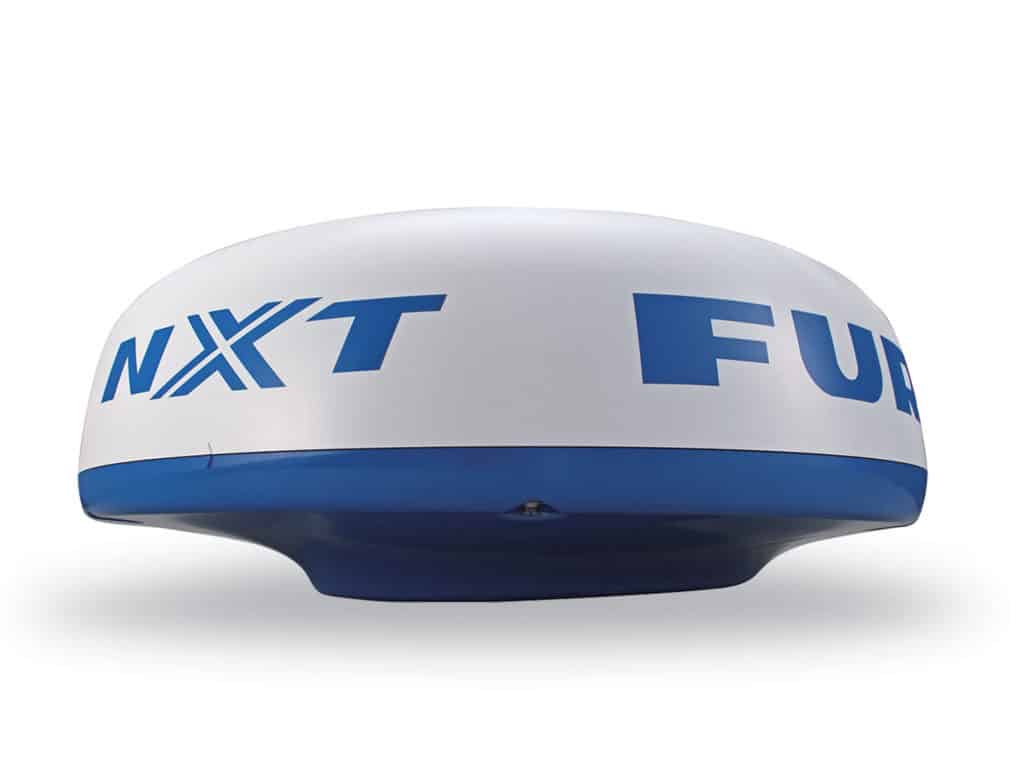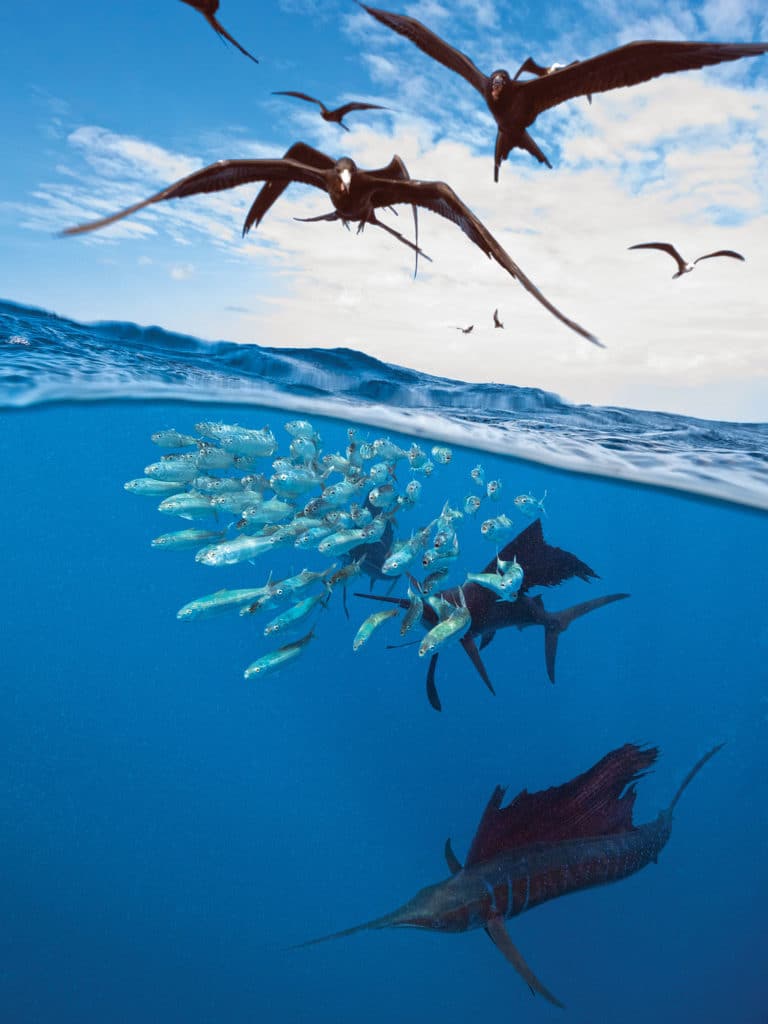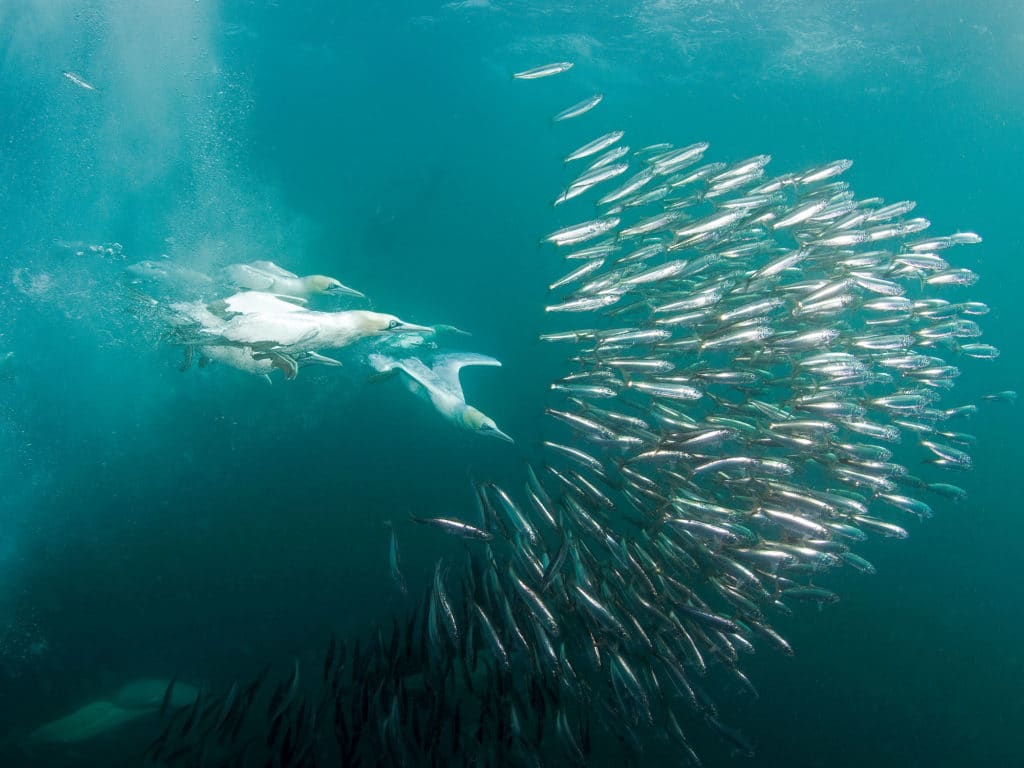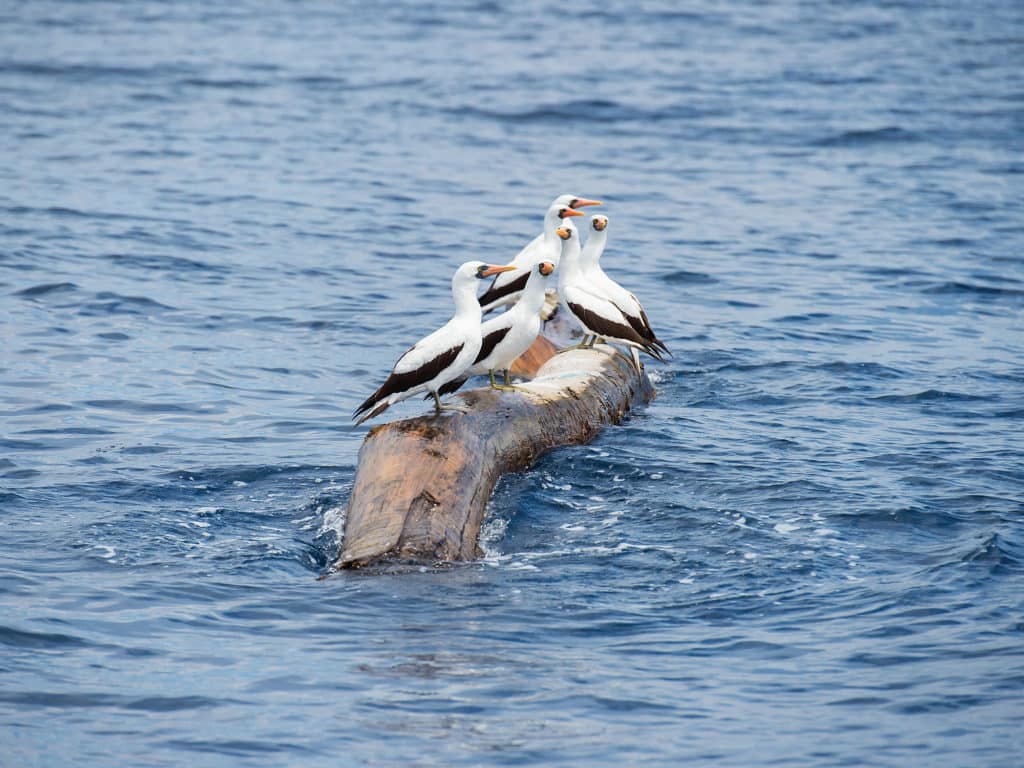
When you’re mesmerized by sonar blips and split-screen Fathometers, it’s easy to overlook the most obvious signs of a bite in this high-tech world — namely, the seabirds circling, dipping and diving in the distance. But whether you’re fishing off Cabo San Lucas, Mexico, Cape May, New Jersey, or Ocean City, Maryland, seabirds can mean the difference between a multimillion-dollar payday and going home busted.
Gannets, terns and other seabirds are unique because they can see parts of the UV-light spectrum that humans can’t, says oceanographer Mitch Roffer, a birder specializing in seabirds. It’s as if they have polarized vision. “Depending on the species, marine birds have either red or yellow oil droplets within their eyes’ color receptors that improve their distance vision — especially in low-light conditions, like haze or at night,” he says. “This enhanced acuity makes it possible for them to see through layers of the color spectrum. As a result, they are superb fish finders because they can see fish where we cannot, especially given their height advantage above the water.”

A Tournament-Winning Advantage
In the West Coast striped marlin sight fishery, anglers rely on sonar to locate shoals of bait underwater. But just as vital are the seabirds that spot bait from high in the air. In this fishery, deckhands and anglers peer through gyroscopic binoculars, continuously scanning for the slightest blur of a bird — or several birds — hovering above tailfins cutting across the surface. These individuals can discern traveling from stationary birds by the speed of wing beats: Long, slow wing beats suggest they are looking for other birds or perhaps a resting spot, and erratic flight or shorter wing beats mean food is near. Flocks cartwheeling and diving are a sure sign of bait and predators below, while singles suggest they’re on the hunt with little to show.
To Capt. Steve Lassley, who with Bad Company has won more than $6 million in West Coast tournaments, birds are an essential part of his program. With owner Anthony Hsieh, he fishes a 45-foot Rybovich off Kona, as well as a 60-foot Viking and a 92-foot Jones-Goodell, from Southern California to Cabo San Lucas. All have unobstructed towers with seating outfitted with armrests to facilitate hours of “glassing,” along with commercial-grade Furuno sonars and radar — essential tools for the sight-fishing technique that he developed in the late ’70s.

Gyrostabilized Vision
“I remember using 7×50 Zeiss binoculars to spot birds and fish, but we switched over to gyrostabilized binoculars when they came out in the ’90s,” Lassley says. “Instead of seeing 2 miles out, we could locate birds pinwheeling at 7 miles. They look like ghosts: here one minute and gone the next. Gyros were game changers, and they’re becoming so for the East Coast fishermen using them now.” Lassley relies on Fraser-Volpe 14-power and Fujinon 12-power units when fishing. Spotters in the tower use the high-power sets for enhanced distance vision, although they do sweep slower; from the cockpit and bridge, Lassley and another crewman use the lighter 12-power Fujinons.

Destin, Florida, captain Randy Baker, who fished his way around the world aboard The Madam and The Hooker, is now pro gyros, and he uses them routinely for spotting birds on bait off Costa Rica, where he’s now based. Innovative East Coast charter captain Brad Simonds of Key West, Florida, uses his gyrostabilized binoculars relentlessly to find birds working over bait schools, preferring the glasses to radar for their ease of use. For Carolinians like boatbuilder Paul Spencer, radar is what most in the mid-Atlantic still use in the white marlin fishery. In other areas offering little or no bottom structure, radar technology has revolutionized how captains spot birds to increase their landings of billfish and tuna.
Radar Tweaking for Birds
“I can locate weed lines and birds 8 miles away,” boasts Capt. Ed Dwyer of the 66-foot Spencer Bear Trap. His first experience using radar to spot birds was as a paying guest in Costa Rica in 1992. By then, he’d pioneered yellowfin tuna fishing at the NOAA weather buoy 110 miles off Port Canaveral, Florida. But when he started using radar back home, he began finding birds and weed lines at 60 miles offshore instead of 110 miles, consistently catching tuna as a result. “I’m not a captain who blind trolls,” he explains. “Birds do a better job locating tuna than I do. While most captains use birds as indicators, they don’t depend on them like we do.”

In the Abacos, his radar is constantly scanning for birds, especially circling frigates and dive-bombing gannets and boobies in the mix. “The great thing about frigates is they’re easy to spot on the radar,” adds Dwyer, who uses a Simrad CHIRP sonar unit in conjunction with his radar when chasing tuna. He sets his radar to show target movement to better observe flight patterns. He observed that yellowfin tuna schools steam northerly most of the time on the eastern side of the Gulf Stream while skipjack swim fast to the south. “If I see birds heading north on the radar screen, I follow them.”
The high-definition 25-kW Simrad open array and the 10-kW system aboard Dwyer’s 42-foot center console also receive routine maintenance. Maximum voltage is required for radar to work well, advises Dwyer, who adjusts the sensitivity to high, but not so high that it’s totally clean. “The screen should clutter out with the gain turned up; if not, the voltage isn’t right,” he says. “I routinely check mine with a voltage meter and inspect the grounding plates for electrolysis.”

Capt. Bobby Brown introduced radar as a tool for locating birds off Kona, Hawaii, in the ’80s after purchasing the 54-foot Bertram No Problem. “The success of using it to find sooty terns over bait pods with skipjack led to others trying it,” he says. “Now everyone uses it.”
For novices, radar is getting easier to use, says Spencer, who has seen an uptick in demand from buyers of his Carolina-built boats. “With the bird settings on the new solid-state Garmin 40W GMR Fantom radar and DRS4D-NXT from Furuno, you don’t need to be an expert to tune one,” he says. Like anything, finesse and practice are helpful for zeroing in on weak targets like birds. Steve Bradburn, one of Furuno’s technical engineers, says there’s less drift in the transmission frequencies of solid-state radars, making the sets more precise and easier to define birds. He clarifies, “But that doesn’t mean all you have to do is turn it on to spot birds 8 miles off.”

Baker agrees: “The more you work with radar, the better you get at reading if a bird is traveling or lifting off the water. What I look for is if the bird is getting bigger — that’s when I run for them. The gyros help with confirmation.”
Deciphering Bird Activity
Blessed with high-powered vision, altitude and the ability to smell, seabirds can be a captain’s sentinels. Yet not every bird is useful for indicating the target pelagic; a good fisherman pays attention to seabirds and develops a database for those that are the best markers, ignoring those that aren’t.

Found throughout the world, shearwaters are important indicators wherever they are found. They might be a slam-dunk for tuna, skipjack and the blue marlin that feed on them off Hawaii, but they are an even better indicator of white marlin in the mid-Atlantic. “Shearwaters flying high or in a straight line means they’re hunting for mackerel, squid or other baitfish,” says Spencer. “If they’re gliding, cutting back and forth or sitting on top with their heads in the water looking deep, there are probably white marlin pushing bait to the surface. With four or five sitting on the surface in a thousand fathoms, the hair on my arm stands up. That’s a recipe for a double-digit day. White marlin chase pilchard, squid and mackerel, and they’ll sometimes eat minnows. If I see shearwaters feeding on minnows, I downsize my tackle.”

Alan Fields, a veteran captain currently running Ship’s Cafe, holds shearwaters and dive-bombing gannets in the highest esteem. An equal-opportunity seabird lover, he believes each has something to tell. With nostrils and the ability to smell, black-and-white storm petrels, aka the chicken of the sea, feed on remnants of bait regurgitated by large tuna. “From Hatteras north, that’s a bird I pay close attention to, especially if there’s sheen on the water — a sure sign of a feeding blue marlin or yellowfin tuna,” he says. “Throughout the Caribbean, Bermuda and Bahamas, the longtail is like finding a pair of aces in your hand. Those are blue marlin birds. If you spot one, take your time and work the area. Nine times out of 10, you’ll be rewarded for it.”
Capt. Jimbo O’Neill steered Luis Bacardi on Rum Bum to multiple wins at the Boy Scout Tournament and the Bermuda Triple Crown. Among seabirds, he rates the tropic bird or Bermuda longtail a perfect 10. “The most prevalent bird in Bermuda is a booby, but anytime you find a longtail there or in the Bahamas, you’ll catch blue marlin,” he says. “They look like terns with a long forked tail; what they do that no other bird does is key on flying squid — the catnip for blue marlin. I can’t tell you the number of times I’ve seen [a longtail] and looked back to find a blue, and sometimes two of three, in my spread.” Few captains realize the importance of flying squid as a forage species for blue marlin, he says. “They’re hard to discern in the water because they look black. But if you find a longtail, you’ll find squid — and blue marlin.”
Frigates and their Counterparts
Frigate or man-o’-war birds mean different things to fishermen depending on where you are in the world. Off Florida and the Bahamas, they are a better indicator of mahimahi than a blue marlin, say captains Peter B. Wright and Ron Schatman. But in the Pacific, especially off Costa Rica, captains like Randy Baker, Bubba Carter and Bobby Brown see them as a promising sight for blue marlin along with mahimahi. “Mature birds are all black, and they’re the ones to pay attention to; the young ones have white heads and are pretty stupid,” Baker adds.

Nick Smith, a Florida fisherman, has been setting records catching Pacific sailfish and striped and blue marlin on fly the past 10 years on his 64-foot Bayliss Old Reliable with Capt. Chip Shafer. Smith says frigates are the best indicator of marlin off Baja, especially Magdalena Bay, where they caught and released 25 striped marlin in a day on fly. “Frigates have the best eyesight of any marine bird,” comments Smith.
The eagles of the sea, frigates don’t necessarily mean blue marlin. But when you see one circling lower and lower to the surface, you can be sure it has its eye on something. Fields adds, “Dolphin, wahoo, sailfish and other pelagics drive bait to the surface, where the vulture-like frigates will swoop in and snatch it from the air, or even from another bird or a game fish driving bait to the surface.”
From Southern California to Mexico’s west coast, Lassley is looking for frigates and, more importantly, jaegers through his gyros. A solitary hunter much like the frigate, jaegers will sit on the surface like a shearwater. He explains: “They fly purposely and usually are in the right position over striped marlin or blues. For me, this makes them a better indicator than frigates, which are too often over dorado.”
Terns and Gannets
Dozens of species of terns are universal indicators of game fish ranging from tuna to billfish. In the Pacific, Lassley uses terns to find anchovies and sauries — halfbeaks similar to ballyhoo that are prime forage for striped marlin. Smith agrees: “Because terns eat what sailfish do, they’ll tell you if bait is being driven to the surface by sails. When Chip [Shafer] sees what he calls ‘happy birds’ because of the chirping sounds, you can bet there are sailfish balling baits.”

When fishing for blues at the North Drop off St. Thomas or for blue or black marlin in deep water from Cabo to Panama, most captains believe birds don’t play a major role helping them find fish. But Simonds believes terns are a positive — especially off Venezuela — and credits them for helping him win many of his back-to-back Billfish Foundation blue marlin release awards as a captain.
Birds also use other birds to find forage. Gannets look for the white flash of fellow gannets when feeding, and Lassley regards them as important markers when fishing off Cabo and Central America. Smith agrees: “Four or five gannets or boobies with their wings pinned back diving deep into the water and popping back up to the surface like a cork a minute later is something you need to pay attention to when fishing the Pacific.”
A Sentinel Brings Luck
Boobies, especially the masked booby and look-alike Nazca booby of the central Pacific, are on Baker’s list of avian favorites. They helped him find a floating tree off Costa Rica in 2015 that made him the only captain in history to catch 20 blue marlin in one day in both the Pacific and Atlantic (a feat he accomplished in 1997 aboard The Hooker off Cape Verde).

With their yellow bills and feet, boobies are distinctive and helpful because of their tendency to settle on logs and other floating debris far offshore. These objects also happen to be natural aggregators for blue and black marlin, explains Baker. “On the first day of a six-day trip offshore to the seamounts, I spotted a masked booby with gyrostabilized binoculars that led me to the log,” he says. “We caught four doubleheader blue marlin out of 18 that day. We drifted that night near the log but had lost it sight of it by morning. After a few hours of looking, a masked booby appeared and led us to it again. The second day, we caught 20 out of 26 blues; on the third day, the boss went 23 for 30. Over the six days, we caught a total of 79 blues — all because of the masked or Nazca booby. It was like he was sent as a sentinel to help us.”

To learn more about these seabirds and how to identify them, visit marlinmag.com/birds.







